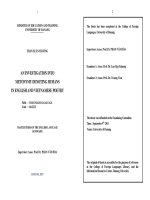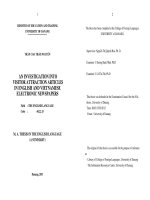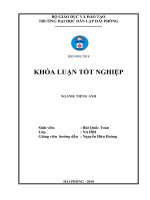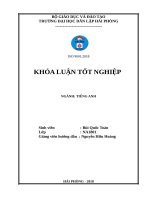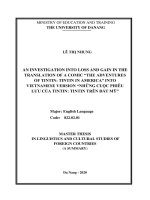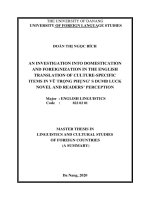An investigation into loss and gain in english vietnamese translational version of the book “happy teachers change the world” by thich nhat hanh and katherine weare
Bạn đang xem bản rút gọn của tài liệu. Xem và tải ngay bản đầy đủ của tài liệu tại đây (142.28 KB, 26 trang )
THE UNIVERSITY OF DANANG
UNIVERSITY OF FOREIGN LANGUAGE STUDIES
TRAN THI THU HUONG
AN INVESTIGATION INTO LOSS AND GAIN IN
ENGLISH - VIETNAMESE TRANSLATIONAL
VERSION OF THE BOOK “HAPPY TEACHERS
CHANGE THE WORLD” BY THICH NHAT HANH
AND KATHERINE WEARE
Major: ENGLISH LINGUISTICS
Code: 822.02.01
MASTER THESIS IN
LINGUISTICS AND CULTURAL STUDIES
OF FOREIGN COUNTRIES
(A SUMMARY)
Da Nang, 2020
This thesis has been completed at University of Foreign
Language Studies, The University of Da Nang
Supervisor: NGUYEN THI THU HUONG PhD.
Examiner 1: Nguyen Quang Ngoan, Assoc. Prof. Dr.
Examiner 2: Le Thi Giao Chi, M.A., M.Ed., Ph.D.
The thesis was orally defended at the Examining
rd
Committee Time: Friday 3 , July, 2020
Venue: University of Foreign Language Studies
- The University of Da Nang
This thesis is available for the purpose of reference at:
- Library of University of Foreign Language Studies, The
University of Da Nang.
- The Center for Learning Information Resources and
Communication - The University of Da Nang.
1
Chapter One
INTRODUCTION
1.1. RATIONALE
Translation is not just a transference of words or expressions
from one language to another but rather a communication of the
meaning and culture of a source language (SL) text by means of the
closest equivalence of a target language (TL) text (Pym, 2010;
Munday 2008; Hatim & Mason, 2005; Bell, 1991; Newmark, 1988;
Nida, 1982). Therefore, translators must clearly understand the
linguistic aspects of SL and TL in terms of lexical, semantic, and
pragmatic meanings, known as explicit and implicit meanings. In
fact, the translation of the implicit meanings is one of the common
problems and most difficult tasks that translators usually face since
they lie under the cultural signs. The implicit meaning refers to the
speaker‟s intention rather than literal words. Such meaning can be
understood through the extra-linguistic aspects of language.
Moreover, this meaning cannot be understood literally without
taking the socio-cultural and situational contexts into account
(Baker, 2011, Cummings & et al, 2011; Malmkjaer, 2005, Nida,
2001). It represents all aspects of life, the totality of meanings, ideas,
and beliefs shared by individuals among the same community.
Consequently, the ways of translating English into Vietnamese
becomes are greatly concerned among readers and translators. This
is the primary reason why the researcher chooses to deeply
investigate this field. The case being analyzed in this research is
translation shifts and loss and gain, key issues in translation studies.
With the need of preserving the intended meaning, when rendering
from one language to another, the translator might use several
2
strategies and make adjustment to the texts in target language, which
causes a bunch of changes and differences in the translated texts.
These were presented by the theory of Loss and Gain by Peter
Newmark (1988), in which Gain refers to the addition of words in
the translated texts, while Loss tends to shorten and simplify the
translated texts. As can be seen that Loss and Gain occur typically in
translation; however, the study in this area is still left untouched.
Moreover, English has been considered as a key tool to help
students go further in their academic study, develop their profession
and integrate into global world; therefore, teaching and learning
English is of considerable importance. Despite positive changes,
teaching and learning English in Vietnam in these days are still
facing a lot of challenges. The researcher of this study has witnessed
that many teachers have tried really hard, even some teachers suffer
from burnouts in classroom but students have shown little
improvement in learning English. This made the researcher have a
great desire to do something to help other teachers through
implementing a research related to English translation of a teaching
guide. Among various kinds of books, the researcher uses the book
written by two outstanding educators Thich Nhat Hanh and
Katherine Weare.
For these above reasons, the researcher decided to conduct
this paper titled “An Investigation into Loss and Gain in English Vietnamese Translational Version of the Book “Happy Teachers
Change the World” by Thich Nhat Hanh and Katherine Weare”,
which is translated into Vietnamese by a group of translators
including Chan Hoi Nghiem, Chan Thuan Khanh, Chan Ky Nghiem
and Chan Tai Nghiem.
3
1.2. RESEARCH AIMS AND OBJECTIVES
1.2.1. Aims
This research is aimed at finding out loss and gain in the
Vietnamese Translation of the Book “Happy Teachers Change the
World”. Additionally, in this study, implications and suggestions are
put forward in order that English teachers, students, translators and
scholars can benefit from this research.
1.2.2. Objectives
The objectives of the present research paper are as follows:
- To identify the loss and gain in the Vietnamese Translation
of the Book “Happy Teachers Change the World”.
- To examine factors causing loss and gain in the process of
translating from English to Vietnamese.
1.3. SCOPE OF THE STUDY
This study focuses on the book: “Happy Teachers Change
the World” by Thich Nhat Hanh and Katherine Weare. In this study,
loss and gain are identified, analyzed and discussed. Additionally,
translation shifts are figured out to see how the ST and TT are
different.
1.4. RESEARCH QUESTIONS
In an attempt to achieve the above mentioned objectives, the
current research seeks to answer the following questions:
- What kind of loss and gain can be found in the Vietnamese
translation of English in the book “Happy Teachers Change the
World”?
- What affects loss and gain in the process of translating
from English to Vietnamese?
4
1.5. THE ORGANIZATION OF THE STUDY
The paper consists of five chapters as follows:
Chapter One - “Introduction”
Chapter Two - “Literature Review and
Theoretical
Background”
Chapter Three - “Research Design and
Methodology”
Chapter Four - “Findings and Discussions”
Chapter Five -“Conclusion – Implications
Recommendations”
Chapter Two
THEORETICAL BACKGROUND
AND LITERATURE REVIEW
2.1. THEORETICAL BACKGROUND
2.1.1. What is Translation?
2.1.2. Types of Translation
2.1.3. Principles of Translation
2.1.4. What is Equivalence?
2.1.4.1. Types of Equivalence
2.1.4.2. Catford’ Shifts
2.1.5. Loss and Gain in Translation
2.1.5.1. The Concept of Loss
2.1.5.2. The Concept of Gain
2.1.6. Types of Loss and Gain
2.2. LITERATURE REVIEW
Several studies have been conducted related to loss and gain
in translation. Tran Thi Mai Le (2012) conducted an investigation
into loss of meaning in the translation process as manifested in the
5
Vietnamese version of “The World is Flat” by Thomas l. Friedman.
The researcher described and analyzed the collected data for finding
out the linguistic and non-linguistic features of loss in meaning
through descriptive and analytical methods. She also clearly
presented several examples of Loss of Connotative Meaning,
Collocative Meaning, Thematic Meaning and reflected meaning.
According to this study, loss in meaning cannot be considered
mistakes but it refers to phenomena in the process of translation each
translator should be aware of in order to make his/ her product
better. Clearly whatever kinds of loss in meaning are, they seem to
be necessary because they can make the target version smoother and
readers can find it more comprehensible and acceptable. However,
the researcher mainly focused on the analyzing the types of loss of
meaning occurring in Vietnamese version of “The World is Flat”
while the types of gain were not investigated.
In the same year, Tran Thi Thao Mien (2016) investigated loss
and gain in the translation of conceptual metaphor expressing “selfidentity” in Trinh Cong Son (TCS)‟s songs into English. The
researcher found out loss and gain in the English translations of
cognitive metaphors of Self-identity for a better understanding of
cognitive metaphors in TCS„s songs. The results showed that
cognitive metaphors of ―Self-identity in Trinh Cong Son„s songs
are rooted in bodily experiences and in experiences with culture and
physical world. Furthermore, results about loss and gain in the
English the translations indicate that loss and gain in such
translations in terms of semantics and syntax are mostly inevitable
due to the influence of the sound beats in the STs, the linguistic and
cultural discrepancies between English and Vietnamese. Loss is also
6
caused by strategies employed by the translators such as using a
more neutral/less expressive words, metonymy, and unrelated words
and phrases. Misunderstanding the author„s ideas is also a
contributory factor for such loss. Loss is more prevalent than gain in
the English translations. Gain, on the other hand, is mostly realized
through expansions or explanations.
Loss and gain in translation is also of great concern. For
instance, Leni Tiwiyanti; Ayu Bandu Retnomurti (2016) studied loss
and gain in translation of culture-specific items in Ahmad Tohari‟s
Lintang Kemukus (Lintang Kemukus is the name of an Indonesian
novel, written by Ahmad Tohari). They identified translation procedures
applied in translating Culture-specific items (CSIs) which caused loss
and gain in the translation process and to identify how the translator
compensated the loss in translating CSIs. They suggested that in order
to compensate the loss that might have occured, translator uses some
translation procedures. They are translation by loan word with
explanation, translation by paraphrase using related word, and
translation by paraphrase using unrelated word. The result showed that
loss is more prevalent than gain although the translator has enough
knowledge on the source text culture as he has spent some years doing
some research loss and gain in translation of culture-specific items in
Banyumas society. There are two kinds of losses found in this research;
inevitable and avertable losses. According to the researchers, inevitable
loss occurs because of the divergent systems of the two languages
regardless of the skill and competence of the translator. In this case,
translators usually can not establish equivalence and therefore resorts to
compensatory strategies. The second loss is an avertable loss attributed
to translator‟s failure to
7
find the appropriate equivalence. Translation procedures which
result in loss in translation are translation by a more general word
(subordinate), translation by a more neutral/less expressive word and
translation by cultural substitution. Gain is realized mostly through
the creativity of the translator when they are able to explain culturespecific items for effective communication. In order to compensate
the loss that might have occurred, translator uses some translation
procedures. They are translation by loan word with explanation,
translation by paraphrase using related word, and translation by
paraphrase using unrelated word. Accordingly, this study with the
combination between loss and gain analysis and factors leading to
this phenomenon would be of necessity for language learners.
Chapter Three
RESEARCH DESIGN AND METHODOLOGY
3.1. RESEARCH METHODOLOGY
With an attempt to achieve the objectives, the study adopts a
descriptive approach, using a combination of qualitative and
quantitative method. The descriptive method in the study is
employed in chapter four to describe the process of translation shifts
found in this study. Moreover, the method is used to describe the
table of occurrences of loss and gain.
According to Silverman (2001), qualitative method, can show
the insights behind the numbers and facts to clarify different layers
of meaning conveyed by the speaker. In linguistics, applying
qualitative method tends to be the most appropriate choice of
language researchers, who use it as the tool to encounter the multiple
meanings as well as the value patterns that quantitative method
8
cannot express (Lincoln and Guba, 1985). The qualitative method in
this study is expressed in analyzing the factors affecting loss and
gain in the process of translating from English to Vietnamese in
chapter four.
Quantitative method is applied to measure „how much‟ and
„how many‟ of the case study (Rasinger, 2013, p10). The quantitative
method in this study is adopted in chapter three to collect samples. This
method is used in chapter four to count the frequency of occurrence of
translation shifts, loss and gain in this study.
3.2. SAMPLING
Samples were taken from the books, including 100 English
samples in the book “Happy Teachers Change the World” and 100
Vietnamese translations in the book “Thay Co Hanh Phuc Se Thay
Doi The Gioi”.
The purposive sampling strategy is employed in this study. In
regard to strategy, Patton (2002) states that purposive sampling is a
technique widely used in qualitative research for the identification
and selection of information-rich cases for the most effective use of
limited resources (Patton, 2002). As for purposive sampling,
Sugiyono (2007) claims that purposive sampling allows the
researcher to collect the data or deliberately choose the data source
due to certain considerations, which fits the research objectives of
the present study. The research adopts this method of sampling in
order to choose samples based on the following classification
criteria: A sample can be a phrase, a collocation or a sentence with
the condition that there is at least one difference between the original
text and its translated text. This difference includes any linguistic
features relating to grammatical and lexical aspects. Despite the fact
9
that samples do not represent all the attributes of the population,
they cover the basic characteristics of typical translated text found in
the book. This way of selecting samples enables the researcher to
meet the objectives of the study.
3.3. RELIABILITY AND VALIDITY
In terms of reliability, as mentioned above, English samples in
the book “Happy Teachers Change the World” and 100 Vietnamese
translations in the book “Thay Co Hanh Phuc Se Thay Doi The
Gioi” were collected. The data were collected from sources which
are reliable. The English samples were taken from the book “Happy
Teachers Change the World”, published in 2017 by Parallax Press,
Berkeley, California. The Vietnamese ones were taken from the
translated book “ Thầy Cô Hạnh Phúc Sẽ Thay Đổi Thế Giới”,
published in 2018 by Thai Ha book and Ha Noi Publishing.
Additionally, the study was carried out on the basis of the theoretical
background as mentioned in chapter 2, and the procedures of study
which would guarantee the consistency of the result of study.
In terms of validity, all English and Vietnamese samples were
selected in a recent period from 2017-2018 and from well-known
publisher. They were exactly the samples that reflect what researcher
really wished to measure concerning the qualitative information to
serve the research questions. All findings in this thesis were clarified
from clear evidence, statistics and frequencies. For that reason, the
validity was also confirmed.
3.4. DATA COLLECTION
The researcher read the book thoroughly to collect all the
samples in the book “Happy Teachers Change the World” and in the
10
Vietnamese translation as mentioned in sampling. The data
collection procedure was carried out as follows:
-
Select samples in the original book
-
Compare with the translated text to see whether there are
any loss and gain
-
Categorize samples
3.5. DATA ANALYSIS
- Firstly, the English samples were collected from the book
- Secondly, the data taken from English and Vietnamese
versions were compared to identify types of translation shifts;
- Thirdly, the identified types of translation shifts, loss and
gain were sought and described from the data;
- Fourthly, the occurrences of loss and gain are worked out;
the result of the frequency was compared with each other and shown
in the pie charts. The frequency of each type of loss and gain was
counted manually. These procedures were adopted to meet the
objectives of the study and to answer the research questions;
- Finally, the researcher interprets the data.
- All in all, this chapter presents justifications of the
researcher for the purposive sampling, data collection procedure
with five stages and data analysis method that this study employed.
Chapter Four
FINDINGS AND DISCUSSIONS
4.1. THE TRANSLATION OF ENGLISH IN THE BOOK INTO
VIETNAMESE
4.1.1. Level shifts
4.1.1.1. Shift from grammar to lexis
11
This subcategory of level shifts relates to the change from a
grammatical item in the ST to a lexical item (i.e. word) in the TT.
Example 1:
Grammar
-es
Contemplative approaches
Lexis
các
Các phương pháp quán niệm
p. 41, book 1
It is clear from the above examples that in the English
language, the morpheme “-s” or “-es” is added to indicate the plural
form of a noun while there is no change in the form of Vietnamese
noun whether it is singular or plural. The words such as “các”,
“những” are served as plural markers. Moreover, translators often
add markers such as “sự”, “việc”, to a noun.
4.1.1.2. Shift from Lexis to Grammar
This level shift deals with a change from a lexical item (word)
in the ST to a grammatical item (i.e. part of the linguistic structure)
in the TT. In the collected data, there is no shift from lexis to
grammar.
4.1.2. Category Shifts
4.1.2.1. Structure Shift
a. Shifts in Word Order
This type of structure shifts takes place when there is a change
in the organization of words in a sentence between the ST and the
TT. The following examples provide a further
explanation: Example 2:
12
ST
TT
True happiness means that you
don‟t need to run after anything
Hạnh phúc chân thật có nghĩa
là ta không còn phải chạy đi tìm
anymore
cầu thêm bất cứ điều gì nữa
p. 23, book 1
True happiness
Adj N
Hạnh phúc chân thật
N
Adj
In this example, there is a structure shift in word order.
Adjective+ noun structure as in the underlined ST phrase (true
happiness) is changed into noun+adjective (hạnh phúc chân thật)
in the TT.
b. Passive-active Voice Shifts
In this subcategory of structural shifts, a change from the
passive voice in the ST to the active voice in the TT, and vice versa,
takes place.
Example 3:
ST
TT
Mindfulness is now being taught
in classrooms in schools and
Các trường phổ thông và đại học
tại một số nước trên thế giới đang
universities in some parts of the
thực hiện chương trình áp dụng
world
chánh niệm vào trường học.
p. 141, book 2
13
This example includes a structure shift from passive to active
voice. The translator changes from passive in the ST to active in the
TT. In this sentence “Mindfulness is now being taught”, the English
passive structure (Subject + be + past participle) is transferred into
an active structure (Subject + Verb).
4.1.2.2. Class shift
Class-shift, when a SL item is translated with a TL item which
belongs to different grammatical class, for example a verb may be
translated with a noun. In the following example, “In a very real
way” is a prepositional phrase in the ST, it is rendered into a verb
phrase in TT, which is a combination of a verb and adverb.
Example 4:
ST
TT
In a very real way, your students
will call that wisdom and
Nói một cách thực tế thì học
trò của bạn sẽ là người khơi mở
discernment out of you.
nguồn tuệ giác đó trong bạn.
p. 18, book 1
ST: In a very real way
Prep
NP
TT: Nói một cách thực tế
VAdv
4.1.2.3. Unit Shifts
Example 5:
TT
Peace is every breath
ST
Bình an trong từng hơi thở
p. 65, book 1
14
Peace is every breath
S
V
C
Bình an trong từng hơi thở
NP
As can be seen, the clause in the SL is changed into a noun
phrase in TL. This translation is highly appreciated because the
translators produce the precise contextual meaning of the original.
Example 6:
ST
TT
Breathing out, “ I send my heart
along with the sound of this bell”
Thở ra, gửi lòng theo tiếng
chuông
p. 93, book 1
ST: I send my heart along with the sound of this bell
S V
O
TT: gửi lòng theo tiếng chuông
VP
4.1.2.4. Intra-System Shift
Example 7:
ST
Enhance awareness of one‟s
thoughts and feelings
TT
Nhận diện sâu sắc hơn về tư
duy, cảm thọ
p. 139, book 1
15
English (Plural)
Vietnamese (singular)
thoughts
feelings
Tư duy
Cảm thọ
In the table above, it can be observed that although in the ST
there is a plural element as “s” is added at the end of the noun, in the
TT there is no signal showing the plural form.
4.2. FREQUENCY OF TRANSLATION SHIFTS
The table below indicates the frequency order of the 5 kinds of
shifts suggested by Catford from the highest to the lowest as follows:
Strategy
Occurrence
Percentage
Structural-shifts
39
29
Class-shifts
31
23
Unit-shifts
Level shifts
28
26
20
19
Intra-system-shifts
12
9
Total
136
100
Table 4.2. Occurrence and Percentage of Shifts
4.3. TYPES OF LOSS AND GAIN
4.3.1. Loss and Gain in Lexis
4.2.3.1. Loss in Lexis
Example 8:
ST
I remind them to breathe a
normal relaxed breath
TT
Tôi nhắc nhở các em thở tự
nhiên và buông thư.
p. 84, book 1
16
The noun phrase “a normal relaxed breath” in the ST is
conveyed into “tự nhiên và buông thư” in TT, which lacks the
meaning of the word breath. However, due to the existence of the
verb breathe and this verb is already translated, translators do not
repeat this word.
Example 9:
ST
…and an advisory
writers, Thay‟s senior
from
the
TT
team of …và đội ngũ các cây bút cố
students, vấn, những học trò của Thiền
Plum
Community
Village sư ở Làng Mai
p.13, book 1
The noun “Community” is completely lost in TT because
“Plum Village” itself is clear enough for readers to understand. The
next example is also another case of loss in lexis without changing
the meaning of the text.
4.3.1.2. Gain in Lexis
Gain in translation refers to the enrichment or clarification of
the ST which enables language and the TT to be flexible and usable
in any social circle (Nozizwe & Ncube, 2014). Gains can either be
deliberate or coincidental. When deliberate, they are a result of the
translators‟ creativity and are aimed at meeting the need of the target
audience linguistically and culturally. Gain in lexis means the
translators produce an addition of the word to provide more detailed
information and transmit the message in SL to TL more closely.
17
Example 10:
ST
TT
I hope this proves to be a seminal
text for educators around the world
Tôi hi vọng bộ sách này sẽ
trở thành tài liệu căn bản,
with an interest in how best to
quan trọng cho những nhà
support the learning and well-
giáo dục trên thế giới để có
being of young people and those
thể hỗ trợ tốt nhất cho việc
who teach them.
học tập và cho hạnh phúc của
những người trẻ cũng như
những người đang mang
trọng trách dạy dỗ các em
p.9, book 1
In the TT, “quan trọng”, which means “important” and “đang
mang trọng trách” that refers to the meaning “take a great
responsibility” are added. There is no existence of these words in ST. It is
possible that translators attempt to highlight the essential role of this book
as a guideline for educators, who profoundly influence students.
Example11:
ST
TT
As you will see, it is a product of
his deep affection for the young
Bạn sẽ thấy nó là kết tinh tình
thương sâu sắc của Thiền sư đối
and his enduring appreciation of
với những người trẻ và sự
the necessity of a wise and kind
mong mỏi không ngừng về một
education
generations.
for
the
future nền giáo dục bồi dưỡng tài và
đức cho các thế hệ mai sau.
p.13, book 1
18
In the translation provided, "bồi dưỡng" is semantically
gained in order to communicatively evoke the concept of education.
4.3.2. Loss and Gain in Structure
Loss and gain in structure take place when there is an addition
or omission that grammatically occurs at any ranks of language
between the ST and the TT. Unit shift and class shift are found in
this type of loss and gain.
4.3.2.1. Loss in Structure
Example 12:
The practice of mindfulness is
the practice of joy. It is an art of
living.
With
Thực tập chánh niệm là phải
vui. Đó là một nghệ thuật sống.
mindfulness, Với niệm, định và tuệ, ta có thể
concentration, and insight you can
chế tác niềm vui bất cứ khi nào
generate a feeling of joy and
ta muốn.
happiness whenever you want.
p.21, book 1
The noun “joy” in ST is translated into the adjective “vui” in
TT. The translation of a noun in ST into an adjective in TT is a
manifestation of shift, particularly structure shift.
4.3.2.2. Gain in Structure
Example 13:
When you practice breathing in
and out mindfully, that is called
Khi ta thở vào, thở ra có ý
thức là ta đang thở chánh
mindfulness of something. When
niệm. Khi ta đi trong ý thức là
you practice walking
mindfully, ta đang thực tập thiền đi. Khi
that is called mindfulness of
walking. When you
ăn sáng trong chánh niệm là ta
eat your đang thực tập thiền ăn. Ta
19
breakfast mindfully, that is called
mindfulness of eating.
không cần phải ngồi suốt ngày
trong thiền đường mới gọi là
thực tập thiền.
P.21, book 1
Noun Phrase
Unit Shift
=>
When you practice breathing in
and out mindfully, that is called
Sentence
Khi ta thở vào, thở ra có ý thức
là ta đang thở chánh niệm.
mindfulness of something.
In SL, “mindfulness of something” is translated into “ta
đang thở chánh niệm”. The totally different structure in the
translation of the nominal phrase is seen in this case. It changes from
noun into a complete sentence. When adapting the theory of
translation shift, it is certainly seen that the unit shift occurs in
transferring the noun into the sentence.
4.3.3. Loss and Gain in Meaning
4.3.3.1. Loss in Meaning
Example 14:
ST
TT
A rose has to be inter-be with the
whole cosmos. That is the
Chúng ta cần có bùn để nuôi sen.
Mọi thứ nương vào nhau để biểu
insight we call interbeing
hiện.
p. 27, book 1
Again, the word “inter-be” is not rendered into Vietnamese.
Therefore, there is a loss in meaning of the “inter-be”. The
translators completely change the original text. The TT is rewritten
20
in a different way, which is clearer for comprehension.
Noticeably, the image of a rose in the ST is familiar in
Western culture. However, it is not common in the Vietnamese
culture and Buddhism. Therefore, the translators use another
replacement, which is a lotus, “sen” to fit the Vietnamese culture
and Buddhism. “Mọi thứ nương vào nhau để biểu hiện” is a free
translation of “That is the insight we call interbeing” in the ST.
The translators do not exactly render word by word; instead, they
explain in another way for better comprehension. This act of
translation can also be considered as a gain in meaning.
4.3.3.2. Gain in Meaning
Example 15:
ST
TT
Freed from over obsession with
possessions and achievements
Thoát khỏi sự ám ảnh quá mức
của tiền tài và danh lợi
p. 60, book 1
In the ST, possessions mean the things you own, which is
rendered into “tiền tài” in the TT. Achievements are what you have
done successfully and “danh” in the TT is used as its equivalent. In
the context, an addition of “lợi” creates a gain in meaning and the
message is still transmitted naturally.
4.4. BOTH LOSS AND GAIN
Example 16:
ST
The insight of interbeing
TT
Hoa là rác, rác là hoa
p. 26, book 1
“Interbeing” is a word that is not defined in the dictionary
yet. It is explained by Thich Nhat Hanh that the pre-fix “inter”
21
combines with the verb “to be,” to create a new verb, inter-be. He
adds “if we look into this sheet of paper even more deeply, we can
see the sunshine in it. If the sunshine is not there, the forest cannot
grow. In fact, nothing can grow. Even we cannot grow without
sunshine.” This word, in the researcher‟s opinion, a religious term
and is likely to hinder readers „understanding. Moreover, there is no
equivalent meaning in the TT. To render the deep message of ST,
translators use a common sentence in Buddhism “hoa là rác, rác là
hoa”. The physical entities “rác”, “hoa” are used to illustrate the
original meaning. However, these images are even more difficult to
understand. It is suggested that the translators should paraphrase the
term “interbeing” and explain in a clearer way.
This case is the combination of both loss and gain. While
there is a loss in the meaning of “interbeing”, there is a gain,
occurring in “hoa là rác, rác là hoa” in the TT.
4.5. FREQUENCY OF LOSS AND GAIN
Table 4.3. Occurrence and Percentage of Loss and Gain
Occurrence Percentage
Loss in lexis
Gain in lexis
35
22
20
13
Loss in structure
11
6.0
Gain in structure
Loss in meaning
18
27
10
16
Gain in meaning
40
23
Loss and gain
Total
21
174
12
100%
22
4.5. FACTORS AFFECT SHIFTS IN THE PROCESS OF
TRANSLATING FROM ENGLISH TO VIETNAMESE
4.5.1. Linguistics differences
4.5.1.1. Plural Nouns
4.5.1.2. Unreal Subject
4.5.1.3. Passive voice
4.5.2. Cultural Features
4.5.3. Religious Dominance
Chapter Five
CONCLUSION – IMPLICATIONS –SUGGESTIONS
5.1. CONCLUSIONS OF THE FINDINGS
This research is aimed at examining the types of loss and gain
occurring in the Vietnamese translation of the Book “Happy
Teachers Change the World”.
In this study, the researcher investigated loss and gain in
Lexis, Structure and Meaning which refer to the omission or the
addition of linguistic features in the TT. These processes involve
changes of word class, structure, and meaning. According to the
analysis, loss was more popular than gain. The most significant
process was loss and gain in meaning, which account for 23 % and
12 % respectively. Totally, the percentage of this process is 35 %.
Religious elements, particularly the engaged Buddhism, are one of
the main factors causing loss and gain in meaning.
Regarding to lexis, loss was more popular than gain, in which the
former‟s percentage was over 20% while the latter‟s one was only
about 13%. In terms of structure, 6.0 % loss occurred whereas the
percentage of gain is 10%. Interestingly, it is observable that loss and
23
gain could occur at the same time in a sentence with 12% in total.
Thirdly, factors causing loss and gain involve linguistic and
cultural differences. It is noted that main linguistic differences
include those in plural nouns, unreal subjects, and passive voice lead
in the loss and gain found in the TT. Further, cultural gaps between
English and Vietnamese create the possibility of loss and gain in
translation. The most noticeable factor causing changes when
rendering English into Vietnamese in this book is cultural factors,
especially the Buddhism.
5.2. IMPLICATIONS FOR TEACHING AND LEARNING
TRANSLATION
Based on the research‟ results, together with the best of the
researchers‟ understanding of the field, there are a several
implications drawn out as contribution to the linguistics as well as to
teaching and learning translation.
Firstly, learners should equip themselves with these
groundings and practice of various shifts occurring in translation
when rendering English into Vietnamese. In order to identify types
of loss and gain, students should be aware of the theoretical
framework of previous scholars and have hands-on practice of
indicating loss and gain in translation.
Secondly, factors affecting loss and gain in translation should
also be considered. This research helps readers have a deeper insight
into the reasons why loss and gain happen in the translational
version of the book and points out some of the unnatural translation
according to the researcher‟s perspectives. It is, therefore,
encouraged to re-translate the some parts of the book. This paper
might pave the path for future research, investigating into new
